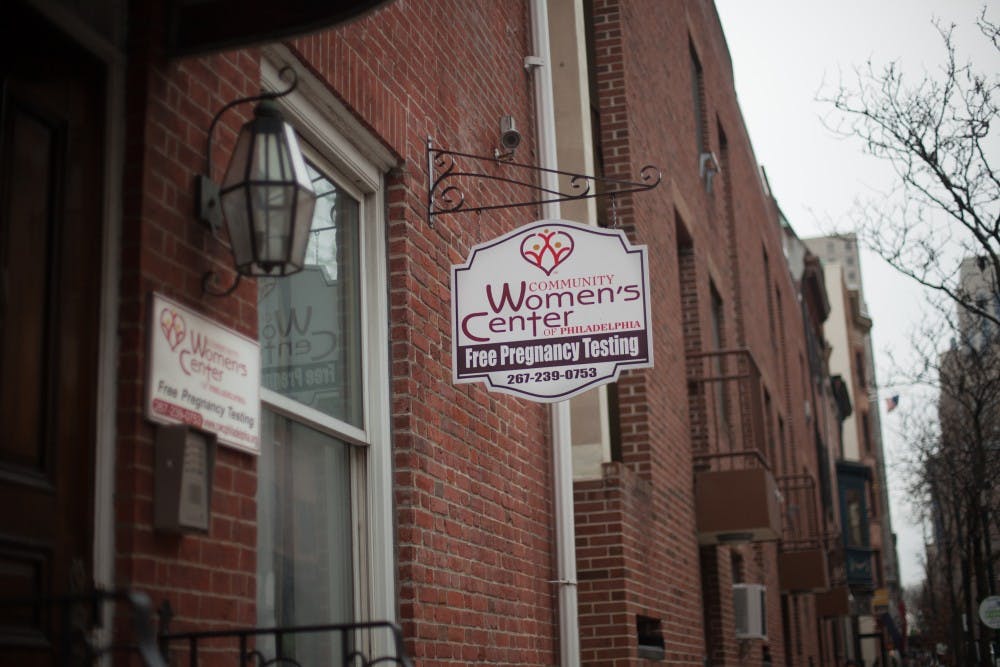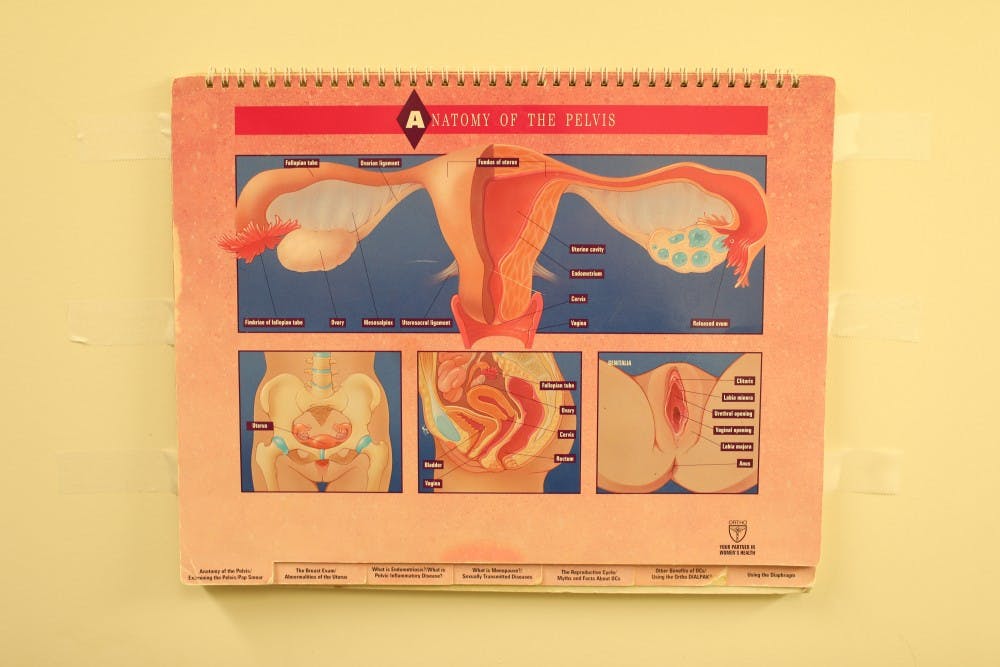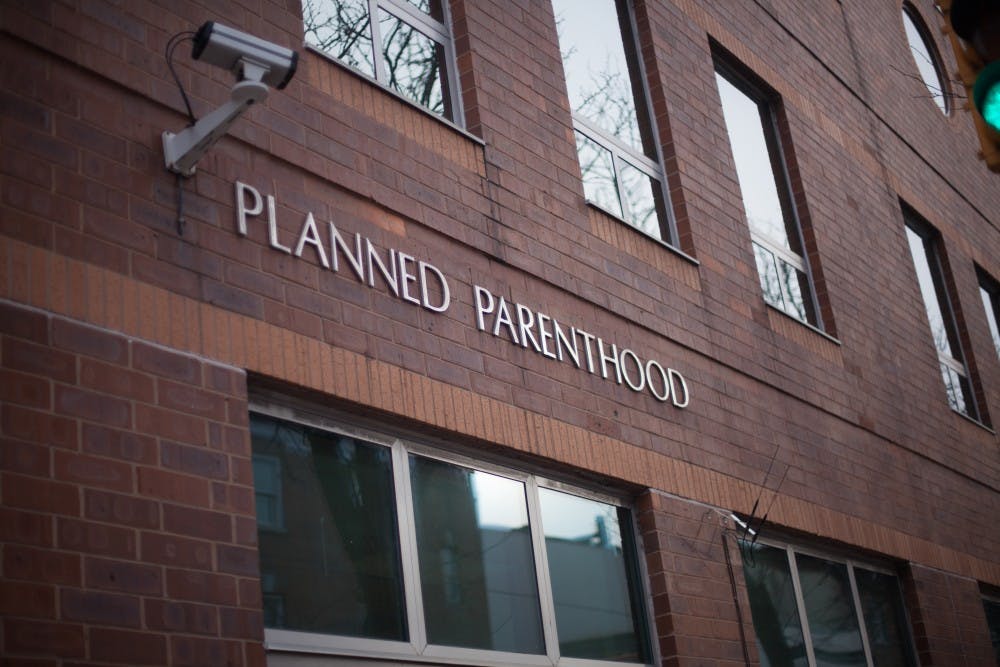“Fifty–eight thousand babies were murdered in there last year! Their blood is on your hands!”
“Please, ma’am, do not let them kill your child!”
“Hail Mary full of Grace, the Lord is with thee. Blessed are thou among women and blessed is the fruit of thy womb Jesus...”
These voices belong to the pro–life protesters who hound the Philadelphia Women’s Center during operating hours, who call themselves “sidewalk servants” or “prayer warriors.”
Two weeks before Christmas, I arrive at the the PWC before they do. It’s 6:30 a.m., and there’s a warm box of Starbucks medium roast waiting for me and the other volunteers when I sign in. Fifteen minutes later, the first protester arrives, and I trudge outside with the only other punctual escort.
During clinic hours, a rope goes up through the middle of the narrow alley off Appletree Street in Center City. The protesters stand on the far side against the chain–link fence at the legally required distance. As for the volunteer escorts, we stay on our side at the entrance to the clinic with bright yellow vests declaring our allegiance. We are here because they are. When women exit their cars, it is our job to usher them into the building, shielding them from the prayers and pamphlets being tossed at them from across the rope barrier.

The security guard pops her head out of the clinic. “Good morning!” she shouts at one of the protesters, Jerry, with a wave. The escorts have clear instructions not to interact with the protesters, but the guard gets a few jabs in when she can. Jerry scowls back at her and grunts, pulling his baseball cap down over his thinning gray hair as he begins to lay out posters against the fence. The guard snickers as the door closes. She knows he won’t be too much of a problem today: Jerry had the cops called on him a month ago.
A few weeks earlier on a mid–November afternoon, I took a five–block stroll to the Community Women’s Center of Philadelphia on the corner of 12th and Locust Streets when my escorting shift had ended. The sign above the door had replaced the letter T in the word “center” with a large cross. At the bottom of the sign, in equally large letters, was printed: “Free pregnancy testing.” To my left, on the adjacent corner, sat the city’s Planned Parenthood location, another abortion provider.
The door in front of me was small, wooden, and windowless. It was also locked.
I pressed the buzzer on the intercom, waited ten seconds, and heard a voice crackle through the other side.
“Hello?”
“Hi,” I responded. “I’m here for a consultation?”
“Do you have an appointment?”
“Um, I was hoping I’d be able to just do a walk–in?”
I was buzzed in and followed the handmade signs up a staircase. I finally located the waiting room, which was unremarkable save for an abundance of lace pillows and framed needlepoint. The woman at the front desk was wearing a set of pink patterned scrubs. It was an odd clothing choice, given that this office does not offer a single medical procedure.
I filled out the sheet she gave me, which asked standard questions about my height, weight, and medical history, but also included multiple questions about my religious background. The questionnaire asked: “Have you taken an at–home pregnancy test and received a positive result?”
I lied and checked “yes."
In the 1980s, the pro–life movement began what has been and continues to be their most successful grassroots effort to date: the establishment of crisis pregnancy centers, or CPCs.
Crisis pregnancy centers are like weeds. Wherever a legitimate abortion provider pops up, three to four CPCs follow. Often, a CPC will brand itself with a similar name to that of the clinic it’s closest to—the Community Women’s Center of Philadelphia was named to imitate the abortion provider called the Philadelphia Women’s Center. But in practice, CPCs aren’t clinics at all, though they frequently market themselves as full–service pregnancy resource centers.

The Community Women's Center of Philadelphia
Crisis pregnancy centers have a reputation for deception. Pro–choice organizations warn that they seek to attract young women with unplanned pregnancies, a population that is the most likely to want abortions but unlikely to have a knowledge of the procedures. Women who have been lured inside with promises of free pregnancy testing and other services frequently report being bombarded with inaccurate and upsetting information about the emotional and physical dangers of abortion.
Fifteen states currently provide direct funding to crisis pregnancy centers. Pennsylvania was the first to do so in 2001, when then–senator Rick Santorum began funneling millions of welfare dollars into CPCs. Thanks to measures like these, there are far more crisis pregnancy centers in the country than there are legitimate abortion clinics.
Here lies the problem: legitimate clinics and CPCs will both tell you that they provide honest, pressure–free, and non–judgmental counseling. They’ll also both tell you that when “those other places” promise that, it’s a total lie.
The Philadelphia Women’s Center deals with many CPCs nearby, but the closest and most worrisome for them is the Community Women’s Center of Philadelphia.
Behind the windowed front desk of the Philadelphia Women’s Center, there sits a basket of black–and–white stickers that read: “Abortion is one hundred percent of what we do.”
Aside from the stickers, the PWC is just a doctor’s office. It’s a place where women receive healthcare. Women coming in for first visits receive a blood test, an ultrasound, a review of their medical history, and any counseling, support, and information they’d like.
During this visit, a woman will learn that her next step, should she choose to have an abortion, will be a consultation with one of the PWC physicians. Patients understand this—it’s standard for any medical procedure.
And for most other medical procedures, that’s where the requirements for informed consent end. In the case of abortions, they involve still another discussion, mandated by the Abortion Control Act. At least 24 hours before the procedure, a qualified clinician is required to provide a patient with a slew of state–mandated information designed to dissuade her from going through with her choice.
The mandated information includes an overview of just about every alternative to abortion. For patients who've done research and made up their minds, these conversations can feel redundant, frustrating, and overly paternalistic.
To start, providers are required to supply detailed information about adoption services. Clinicians are also required to make sure patients know that they have a legal right to child support payments from the father of the child, should they decide to keep it. And, lastly, before a patient can be cleared to come back in for her procedure, she must sign off on a form confirming that she’s received all of this information. The legislature demanding all this uses the phrase “unborn child” in lieu of “fetus.”

In late November, the elevator by the Philadelphia Women’s Center’s alleyway entrance broke down, forcing patients to enter the building through the larger 8th Street entrance. With the entrance more visible to cars and pedestrians, the protesters were bolder than usual. Within ten minutes of the clinic opening, a security guard needed to call a police officer over to calm Jerry, who’d thrown a tantrum over the cones delineating his boundary. He was adamant that they extended beyond the minimum distance he was allowed to stand from the patients.
“WHY DO THESE PEOPLE WANT BABIES TO DIE, LORD?”
He’d carried a large wooden cross with him that day, shaking and staring at the cars that drove by like a quivering, rage–filled Jesus.
When I handed back my intake sheet, the woman at the front desk of the Community Women’s Center of Philadelphia asked if I felt like I could produce a substantial urine sample or if I needed a glass of water first. I told her I was good to go, and when she handed me a cup, I took my jacket off and laid my purse down on a table before heading into the bathroom. I had been here before—though I knew she didn’t recognize me—and trial and error had taught me that bringing a purse into the bathroom would be a giveaway that I’m packing someone else’s urine.
I told her I would be out in a minute and closed the door behind me. I removed my shirt, and was as quiet as possible when I peeled the duct tape off my shoulder and arm to get to the mini liquor bottle full of urine I jammed into my armpit. It’s rich in human chorionic gonadotropin, or HCG, a hormone produced by the placenta during implantation. It came from someone many months pregnant, so it’s sure to read positive.
It was still warm, but not quite body temperature. When I poured it into their sample cup, I decided to top it off with some of my own. The bottle went back in place, and I delivered a cup full of pee that was sure to pass a pregnancy test to the woman waiting outside.
I was ushered into a small room to wait. I expected the Community Women’s Center to look like a medical office. Instead, I was met with a cubicle–sized room that was purple from floor to ceiling—hideous lavender walls, a blue–purple sofa and armchair, a watercolor painting of palm trees and an ocean home, and an enormous, frilly, purple pillow.
A pretty woman with cropped brown hair and a dainty cross around her neck eventually came into the room. She introduced herself as Bernadette and presented me with a piece of paper. “I’ll just need you to sign along the bottom line here, saying that you know you’ve had two pregnancy tests, and they’re both positive.”
I signed and she sat down across from me, flashing a smile. “So, can you tell me a little bit about what brings you in today and what’s on your mind?”
It’s been 45 years since the Philadelphia Women’s Center opened its doors as the first outpatient abortion provider in the state of Pennsylvania. When the United States Supreme Court passed its groundbreaking Roe v. Wade ruling in 1973, guaranteeing women their constitutional right to abortion, the clinic staff was elated. Over the next decade, four more Women’s Centers were opened within the network.
The expansion of women’s right to healthcare was short–lived. In 1989, then–governor Bob Casey championed Pennsylvania’s Abortion Control Act, the first attempt by a state to limit abortion rights after Roe v. Wade. When it passed successfully, many more followed.
Abortion rights are currently the most restricted they’ve been since before 1973, and regulations are continuing to tighten. Of the 1,142 state–enacted abortion restrictions that had been passed nationwide as of 2016, 30% of them were put in place after 2010.
My conversation with Bernadette lasted 40 minutes, during which she repeated at least ten different times that my first step would be to schedule an appointment for a free ultrasound either in their office or at their Bucks County location. When I pushed her about what my options will be in terms of post–ultrasound abortive procedures, she explained both the dilation and evacuation (D&E) and abortive pill options to me, but continued to repeat that I would have to go see a board–certified OB–GYN beforehand. As expected, she couldn’t refer me to one or make any suggestions.
She spoke in a calm tone, and the information I was given is mostly true, but I notice that she discussed certain risks of the procedures as if they are far more common than they actually are. She warned me of the following in a heavy tone:
On the abortion–inducing mifepristone pill: “If you noticed heavy bleeding continuing 24 hours after the expulsion, we would urge you to get to a hospital quickly, because that’s not normal.”
On the D&E procedure: “Because of the rod that they use to dilate the cervix, some women find that after they’ve had this procedure it can be difficult for them to conceive or carry a child down the road because the muscles have been loosened. So that’s something to think about before you make any decisions.”
On both: “If any parts of the pregnancy are left behind, it can cause a really severe infection, so if you have any pain before a two–week check–up appointment, or if you develop a fever, you’d want to get to the hospital right away, because that infection can get really serious really quickly.”

A 2014 systematic review published at the University of North Carolina found that the incidence of post–procedure health issues was six in 100,000. According to Dr. Janice Asher, Director of the Women’s Health department of Penn’s Student Health Services, any health risks posed by abortion procedures are almost entirely eradicated by required check–ups with a physician: one day later for the mifepristone pill, and two weeks later for a dilation and evacuation.
“In terms of life–threatening or life–taking infections, we saw that in the era of illegal abortions,” says Dr. Asher. “It’s so rare now. But when they were illegal that was a huge problem.”
“No matter what,” she adds, “the chances of dangerous complications during pregnancy are exponentially higher.”
As I’d expected, Bernadette talked about adoption in a more positive light, and offered to set me up within the week with a lawyer who can advocate on my behalf, for free, with an adoption organization. “It’s a really courageous act,” she told me. “It’s very selfless. You can even start going through the process of setting up an adoption plan before you make a decision, just so you know that it’s there if you decide you want it.”
She was pushing me, but only subtly. I was surprised that there wasn't yelling, berating, shaming, bullying, or any sort of scare tactics going on inside this crisis pregnancy center. Crisis pregnancy centers operate with subtlety at all levels—not just from the outside, but during intimate consultations as well. If I were less informed about the logistics of getting an abortion, her quiet denial of Planned Parenthood’s services would seem like an omission of crucial information about my healthcare.
The counselors at the Community Women’s Center don’t like talking about the Planned Parenthood next door. Bring it up, and they’ll balk, dodge the question entirely, or suggest that student health services at local universities offer cheaper options.

Planned Parenthood
It’s an ironic runaround, given that the majority of pregnant students who seek abortions after visiting Penn’s Student Health Services actually end up going to Planned Parenthood.
Although SHS doesn’t provide abortion services, SHS Women’s Health nurse practitioner Perri Stella has seen countless students over the years who came to SHS first after learning of an unplanned pregnancy.
“We counsel students with regards to options,” says Stella, “then refer them to either PEACE, Planned Parenthood, or the Philadelphia Women’s Center.”
PEACE, the family planning center at the Hospital of the University of Pennsylvania, is often the cheapest option for students covered by the Penn Student Insurance Plan, although Stella says that most students choose the off-campus options if they can. An abortion at PEACE requires a visit to the operating room at 3400 Spruce Street, while Planned Parenthood and the Philadelphia Women’s Center specialize in outpatient services.

“I even had one student go over to a Planned Parenthood in New Jersey a few years ago,” says Stella. “New Jersey doesn’t have the same required meeting with the 24–hour wait, so she felt more comfortable traveling over there.”
Dr. Asher has only seen two women in her 29 years at Student Health who chose adoption. “If someone wants to have an abortion, they’re going to have an abortion,” she says. “Our big concern is that they be physically and emotionally safe. Abortion can be emotionally difficult, even when it’s the right decision.”
“I’ll tell you the biggest health risk someone faces when getting an abortion—and I’m being completely un–ironic here,” says Dr. Asher. “It’s driving or crossing the street to get to the abortion center.”
Operating abortion–providing facilities under a mountain of legislation is challenging, and many clinics have been forced throughout the decades to shutter their doors. Today, roughly 87% of counties in Pennsylvania don’t have an active abortion provider.
In the 13% of counties with abortive services, women are besieged with insults when they approach clinic doors.
The protesters get too close nearly every time a patient walks into the building. “You are committing murder!” they shriek. “These people don’t care about you or your baby!”
If the patient walking in looks even vaguely Latina, they yell the few phrases they know in Spanish: “Jesús te ama! Por favor salva a tu bebé!”
If the patient is black, they will repeat the same warning until they are hoarse: “They target black people in there, ma’am! Don’t listen to those yellow–vested vultures!”
The majority of the escorts are white, and the majority of patients are not. Not only does the clinic murder, they believe, but it murders with a eugenic purpose, one that we escorts are in on. A massive sign that Pat used to hold out front of the clinic was designed to hammer this idea home. On four lines, it read:
LIVES MATTER
BLACK LIVES
POLICE LIVES
ALL LIVES
One day, Pat left it behind. It was never seen again.
A previous version of this article stated that The Children's Village stole the sign and destroyed it. Since the time of its publication, we later understood this statement to be inaccurate. 34th Street regrets this error.
